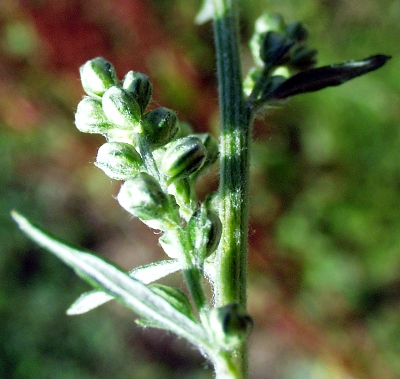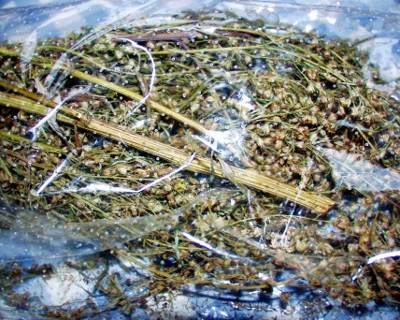Mugwort |

Before
the opening of the small flower heads,
the herb is most
aromatic

The mugwort (Artemisia
vulgaris) appears greygreen
and often grows on
fences

Dried
mugwort is around the Christmastime
often offered in food
markets
Mugwort as a medicinal and culinary herb
The herb that can be used for medical purposes and for seasoning, is very common throughout the Emsland. The leaves and inflorescences should be collected around July, before the flower heads have opened. The roots can be harvested even later in the autumn. For the drying the mugwort is bundled and hung upside down in a shady, dry place. Once it is dry, leaves and flowers can be stored cool and dark in jars with screw caps. The roots can be dried in the oven.
A tea made from wormwood leaves, flowers or roots is intended to help against colds, insomnia, upset stomach and loss of appetite, but also against menstrual cramps and problems during menopause. Already Dioscorides reported about Artemisia, it might expel the fetus, why in pregnancy mugwort should not apply. At fault are essential oils that act on the uterus. The intake over several weeks is not advisable because the plant, even in lower dosages, contains the neurotoxin thujone.
For seasoning the leaves are used. They should give the Christmas goose a slightly bitter taste and make the food easily tolerable. As a culinary herb it is also suitable for many other dishes such as lamb, venison, eel or liver, as well as for vegetable dishes and soups.
Historical publications
Hildegard of Bingen (1098–1179) reported on "Biboz", cooked as gruel, it was very useful because it would heal the sick stomach and the intestines. Against stomach pain after eating and drinking, mugwort was cooked and eaten. It would took away the putrefactions, which would have formed by the food and drink.
Leonhart Fuchs (1501–1566) wrote about the mugwort, it'd also called "St.-Johannisgürtel" (St. John's belt), which was based on a superstition of the Germans. Many people would have girded themselves on St. John's day with mugwort, and afterwards, they threw it with many sayings and rhymes into a bonfire. For the same reason the mugwort would also called "Sonnenwendgürtel" (solstice belt).
Interesting notes
-
Under the mugwort roots, excavated in Midsummer Day (June 24), according to an old story, could be find coals, which worn around the neck, would help against epilepsy. Already Hieronymus Bock, also named Tragus (1498–1554) doubted this, calling the alleged coals "Lapides stultorum" (stones of fools).
-
Approximately every 4th person with pollen allergy reacts to mugwort pollen with hay fever.
-
A small pillow filled with dried mugwort should cause lucid or vivid dreams, or make it easier to remember it.